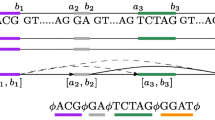Abstract
Producing spliced EST sequences is a fundamental task in the computational problem of reconstructing splice and transcript variants, a crucial step in the alternative splicing investigation. Now, given an EST sequence, there can be several spliced EST sequences associated to it, since the original EST sequences may have different alignments against wide genomic regions.
In this paper we address a crucial issue arising from the above step: given a collection C of different spliced EST sequences that are associated to an initial set S of EST sequences, how can we extract a subset C′ of C such that each EST sequence in S has a putative spliced EST in C′ and C′ agree on a common alignment region to the genome or gene structure?
We introduce a new computational problem that models the above issue, and at the same time is also relevant in some more general settings, called Minimum Factorization Agreement (MFA). We investigate some algorithmic solutions of the MFA problem and their applicability to real data sets. We show that algorithms solving the MFA problem are able to find efficiently the correct spliced EST associated to an EST even when the splicing of sequences is obtained by a rough alignment process. Then we show that the MFA method could be used in producing or analyzing spliced EST libraries under various biological criteria.
Preview
Unable to display preview. Download preview PDF.
Similar content being viewed by others
References
Ausiello, G., Crescenzi, P., Gambosi, V., Kann, G., Marchetti-Spaccamela, A., Protasi, M.: Complexity and Approximation: Combinatorial optimization problems and their approximability properties. Springer, Heidelberg (1999)
Bonizzoni, P., Mauri, G., Pesole, G., Picardi, E., Pirola, Y., Rizzi, R.: Detecting alternative gene structures from spliced ests: A computational approach. Journal of Computational Biology 16(1), 43–66 (2009) PMID: 19119993
Bonizzoni, P., Rizzi, R., Pesole, G.: Computational methods for alternative splicing prediction. Briefings in Functional Genomics and Proteomics Advance 5(1), 46–51 (2006)
Brett, D., Hanke, J., Lehmann, G., Haase, S., Delbruck, S., Krueger, S., Reich, J., Bork, P.: EST comparison indicates 38% of human mRNAs contain possible alternative splice forms. FEBS Letters 474(1), 83–86 (2000)
Caceres, J., Kornblihtt, A.: Alternative splicing: multiple control mechanisms and involvement in human disease. Trends Genet. 18(4), 186–193 (2002)
Castrignanò, T., D’Antonio, M., Anselmo, A., Carrabino, D., Meo, A.D.D., D’Erchia, A.M., Licciulli, F., Mangiulli, M., Mignone, F., Pavesi, G., Picardi, E., Riva, A., Rizzi, R., Bonizzoni, P., Pesole, G.: Aspicdb: A database resource for alternative splicing analysis. Bioinformatics 24(10), 1300–1304 (2008)
Castrignanò, T., Rizzi, R., Talamo, I.G., Meo, P.D.D., Anselmo, A., Bonizzoni, P., Pesole, G.: Aspic: a web resource for alternative splicing prediction and transcript isoforms characterization. Nucleic Acids Research 34, 440–443 (2006)
Eyras, E., Caccamo, M., Curwen, V., Clamp, M.: ESTGenes: alternative splicing from ESTs in Ensembl. Genome Res. 14, 976–987 (2004)
Galante, P., Sakabe, N., Kirschbaum-Slager, N., de Souza, S.: Detection and evaluation of intron retention events in the human transcriptome. RNA 10(5), 757–765 (2004)
Gupta, S., Zink, D., Korn, B., Vingron, M., Haas, S.: Genome wide identification and classification of alternative splicing based on EST data. Bioinformatics 20(16), 2579–2585 (2004)
Heber, S., Alekseyev, M., Sze, S., Tang, H., Pevzner, P.: Splicing graphs and EST assembly problem. Bioinformatics 18(suppl. 1), S181–S188 (2002)
Kan, Z., Rouchka, E.C., Gish, W.R., States, D.J.: Gene structure prediction and alternative splicing analysis using genomically aligned ESTs. Genome Res. 11(5), 889–900 (2001)
Kim, N., Shin, S., LeeSanghyuk: Ecgene: genome-based est clustering and gene modeling for alternative splicing. Genome Research 15(4), 5 (2005)
Lacroix, V., Sammeth, M., Guigó, R., Bergeron, A.: Exact transcriptome reconstruction from short sequence reads. In: Crandall, K.A., Lagergren, J. (eds.) WABI 2008. LNCS (LNBI), vol. 5251, pp. 50–63. Springer, Heidelberg (2008)
Leipzig, J., Pevzner, P., Heber, S.: The Alternative Splicing Gallery (ASG): bridging the gap between genome and transcriptome. Nucleic Acids Res. 32(13), 3977–3983 (2004)
Raz, R., Safra, S.: A sub-constant error-probability low-degree test, and a sub-constant error-probability PCP characterization of NP. In: STOC, pp. 475–484 (1997)
Wu, T.D., Watanabe, C.K.: Gmap: a genomic mapping and alignment program for mRNA and est sequence. Bioinformatics 21(9), 1859–1875 (2005)
Xie, H., Zhu, W., Wasserman, A., Grebinskiy, V., Olson, A., Mintz, L.: Computational analysis of alternative splicing using EST tissue information. Genomics 80(3), 326–330 (2002)
Xing, Y., Resch, A., Lee, C.: The multiassembly problem: reconstructing multiple transcript isoforms from EST fragment mixtures. Genome Res. 14(3), 426–441 (2004)
Xu, Q., Modrek, B., Lee, C.: Genome-wide detection of tissue-specific alternative splicing in the human transcriptome. Nucleic Acids Res. 30(17), 3754–3766 (2002)
Author information
Authors and Affiliations
Editor information
Editors and Affiliations
Rights and permissions
Copyright information
© 2009 Springer-Verlag Berlin Heidelberg
About this paper
Cite this paper
Bonizzoni, P., Della Vedova, G., Dondi, R., Pirola, Y., Rizzi, R. (2009). Minimum Factorization Agreement of Spliced ESTs. In: Salzberg, S.L., Warnow, T. (eds) Algorithms in Bioinformatics. WABI 2009. Lecture Notes in Computer Science(), vol 5724. Springer, Berlin, Heidelberg. https://doi.org/10.1007/978-3-642-04241-6_1
Download citation
DOI: https://doi.org/10.1007/978-3-642-04241-6_1
Publisher Name: Springer, Berlin, Heidelberg
Print ISBN: 978-3-642-04240-9
Online ISBN: 978-3-642-04241-6
eBook Packages: Computer ScienceComputer Science (R0)




